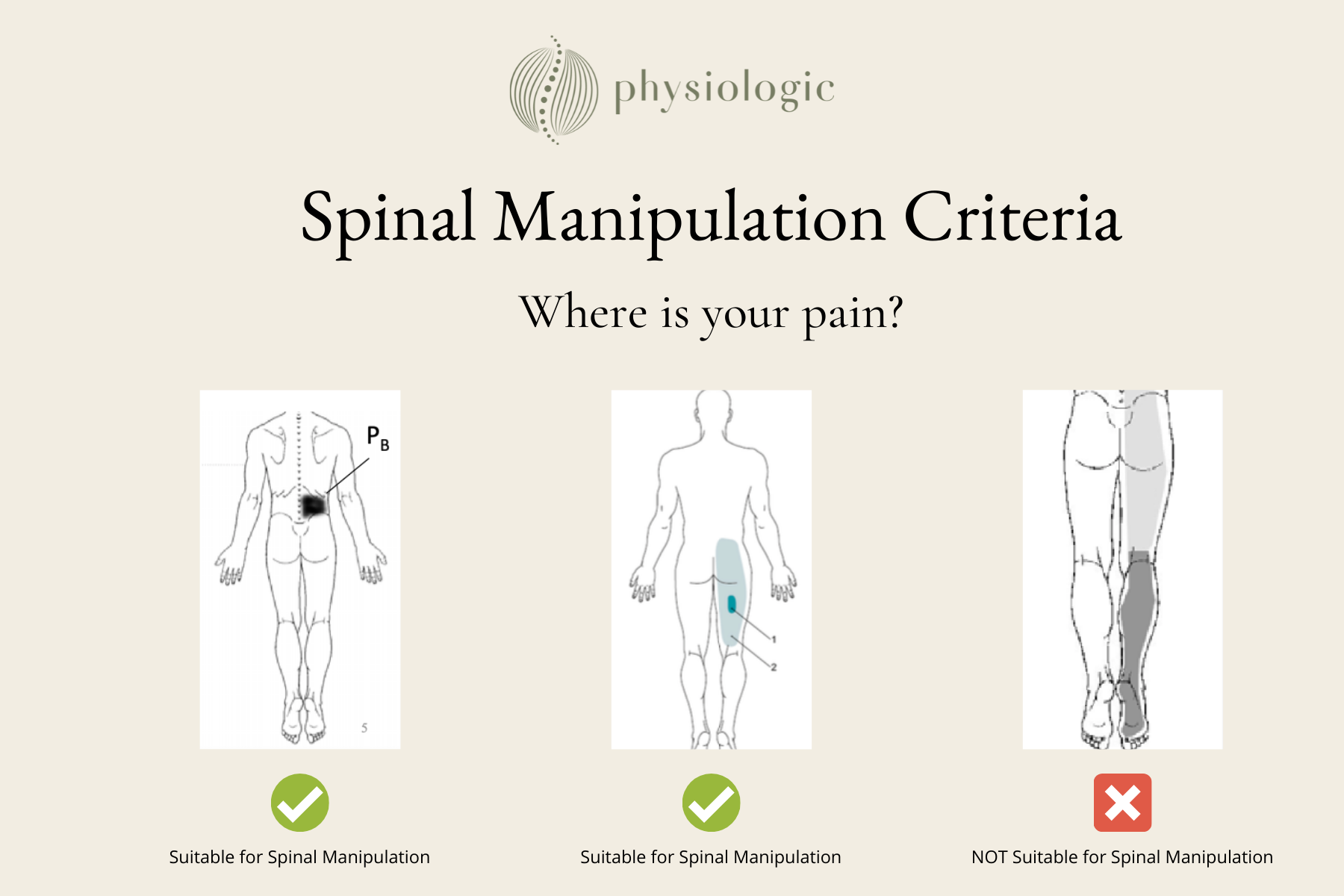Spinal Manipulation for Back Pain Relief
Spinal manipulation, otherwise known as adjustments or back cracking, is used by manual therapists like Physiotherapists, Chiropractors and Osteopaths to try and relieve lower back pain and improve spinal mobility.
But what is actually happening when you have your spine manipulated, and is it right for you?
Let’s start off by analysing what actually happens at the joint during a spinal manipulation.
SPINAL MANIPULATION MECHANICS
When the therapist performs the spinal manipulation technique, they are applying a high velocity thrust to a specific spinal segment that forces it to move past its normal physiological range of movement.
The result is a ‘gapping’ phenomenon within your spinal joint, and a release of gas and pressure occurs. This is when you hear the ‘click’ sound.
Check out the video below to see a quick demonstration of a Lower Back (Lumbar) Manipulation and Thoracic (Mid Back).
DO SPINAL MANIPULATIONS ACTUALLY HELP?
In the physio world - this is such a hot topic of debate, its manual therapists vs pain scientists, all arguing on how it actually works, and whether we should even bother with it!
My personal (and professional) opinion?
Spinal manipulations are helpful, for the right person, at the right time. They work best when given in conjunction with active exercises aimed at addressing the root cause of the person's dysfunction.
Simply, what I mean is that it’s fine to use manipulations to help reduce pain in the short term, but for long term solutions, rehabilitation specific to the person's injury should be the main focus.
HOW DOES IT WORK?
Most clinicians will explain to their clients that manipulating a joint is ‘loosening it’ or ‘unlocking’ the joint, maybe even ‘realigning’ your spinal posture. That’s easy for clients to understand and buy-in to the idea of having their back cracked.
But is that the main mechanism that helps to reduce your pain?
We’ve simplified the libraries of research in the physiotherapy world, and broken down the mechanism of action to 2 main routes.
Physical and Neurological.
PHYSICAL MECHANISM OF ACTION
After a spinal manipulation, you will physically, and temporarily, experience an increase in your mobility and hopefully, a reduction in your pain.
The physical action of a manipulation creates a gapping sensation in your spinal joint, therefore temporarily giving you more movement as the high velocity thrust pushes the joint past its normal range of movement.
NEUROLOGICAL MECHANISM OF ACTION
The neurological route, which I (and many others) believe is a much more powerful mechanism to explain why Spinal Manipulations work.
The neurological pathways between your spine and brain are so complex, but let’s try to simplify it in a digestible, easy to understand way.
First of all, we need to establish the fact that your brain is the processing centre that determines how you feel, and what to do about that feeling.
For example, if you touch a hot pan with your left hand, you don’t ‘feel’ the heat in your hand.
Your brain is telling you that your left hand is hot, and its response is to quickly take your left hand off.
Let’s apply this to a spinal manipulation.
1: Your back feels tight and sore, joints are locked up and muscles tightened up.
2: Your physiotherapist performs a spinal manipulation on your back.
3: The joint that is being manipulated senses that it has just been ‘released’, which is a POSITIVE stimulus. This positive stimulus also happens to ‘block’ pain signals from going to the brain.
4: This positive stimulus is sent up to the brain, and the brain warmly receives this positive message. It also perceives less pain as the pain signals have been blocked from arriving at the brain.
5: Now that your brain perceives less pain, it responds by telling the nerves that look after your back muscles to relax, which in turn makes you feel ‘looser’, while you feel less pain.
This is obviously a very simple way to describe the neurological mechanism, however it can actually be applicable to most manual therapy techniques!
Are Spinal Manipulations right for me?
If you are looking for some pain relief from your lower back pain, here are some criteria that will help determine if you would benefit from a spinal manipulation.
Note: these criteria are taken and simplified from the Clinical Prediction Rules that your Physiotherapist should use to determine if Spinal Manipulations are appropriate for you.
Back pain less than 16 days
No pain referring below the knees
Hip Internal rotation >35 degrees (in at least 1 of your hips)
Stiffness in at least one spinal segment.
IMPORTANT - Spinal Manipulations can be very helpful in the SHORT TERM to help reduce your pain, and improve your mobility.
For Long Term solutions, you must pair the Physiotherapy treatment for your lower back with active rehabilitation that directly addresses the cause of your pain.
Our team at Physiologic are experts at treating Spinal issues, using a combination of hands on techniques including manipulations, with active rehabilitation protocols that are aimed at addressing the root cause of your injury.
Contact Us to find out how we can help you find long term solutions for your lower back pain!
As long as your pain does NOT travel below your knee, Spinal Manipulations may be appropriate for you.
About the author
Ryan Tan is our Clinical Director and Physiotherapist here at Physiologic Hong Kong. His main clinical interests lie in treating spinal conditions and utilising strength training principles in his rehab programs. He has a Certificate of Spinal Manual Therapy from Manual Concepts, the world leader in Post Graduate Spinal specialisation, ensuring he can provide an accurate diagnosis and effective treatment plans even for many complex cases. Clinically, he works in close collaboration with some of Hong Kong’s top spinal surgeons, bringing his blend of treatment and rehabilitation to get the best results for his clients. Looking to bridge the gap between your traditional physio ‘treatment’ and building a strong, injury-proof body? Reach out to us here to see how we can help!

